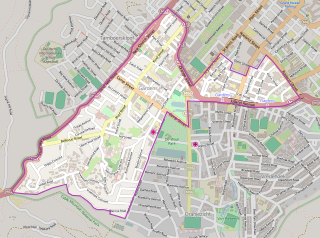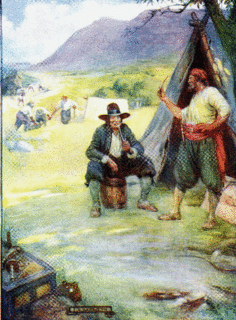Related Research Articles

Boer is Dutch and Afrikaans for "farmer". In South African contexts, "Boers" refers to the descendants of the proto-Afrikaans-speaking settlers of the eastern Cape frontier in Southern Africa during the 18th and much of the 19th century. From 1652 to 1795, the Dutch East India Company controlled this area, but the United Kingdom incorporated it into the British Empire in 1806.
The written history of the Cape Colony in what is now South Africa began when Portuguese navigator Bartolomeu Dias became the first modern European to round the Cape of Good Hope in 1488. In 1497, Vasco da Gama sailed along the whole coast of South Africa on his way to India, landed at St Helena Bay for 8 days, and made a detailed description of the area. The Portuguese, attracted by the riches of Asia, made no permanent settlement at the Cape Colony. However, the Dutch East India Company (VOC) settled the area as a location where vessels could restock water and provisions.

Johan Anthoniszoon "Jan" van Riebeeck was a Dutch navigator and colonial administrator who arrived in Cape Town in what then became the Dutch Cape Colony of the Dutch East India Company.
The following lists events that happened during the 1660s in South Africa.
The following lists events that happened during the 1670s in South Africa.
The following lists events that happened during the 1680s in South Africa.
The following lists events that happened during the 1690s in South Africa.

Hout Bay is a seaside suburb of Cape Town in the Western Cape province of South Africa. It is situated in a valley on the Atlantic seaboard of the Cape Peninsula, twenty kilometres south of the Central Business District. The name "Hout Bay" can refer to the suburb, the bay on which it is situated, or the entire valley.

The Castle of Good Hope known locally as the Castle or Cape Town Castle is a bastion fort built in the 17th century in Cape Town, South Africa. Originally located on the coastline of Table Bay, following land reclamation the fort is now located inland. In 1936 the Castle was declared a historical monument and following restorations in the 1980s it is considered the best preserved example of a Dutch East India Company fort.
The area known today as Cape Town has no written history before it was first mentioned by Portuguese explorer Bartholomeu Dias in 1488. The German anthropologist Theophilus Hahn recorded that the original name of the area was '||Hui !Gais' – a toponym in the indigenous Khoe language meaning "where clouds gather."
The Khoikhoi–Dutch Wars were a series of conflicts that took place in the last half of the 17th century in what was known then as the Cape of Good Hope, in the area of present-day Cape Town, South Africa, between Dutch settlers who came from the Netherlands and the local African people, the indigenous Khoikhoi, who had lived in that part of the world for millennia.
Although the Portuguese basked in the nautical achievement of successfully navigating the cape, they showed little interest in colonization. The area's fierce weather and rocky shoreline posed a threat to their ships, and many of their attempts to trade with the local Khoikhoi ended in conflict. The Portuguese found the Mozambican coast more attractive, with appealing bays to use as waystations, prawns, and links to gold ore in the interior.

Gardens is an inner-city suburb of Cape Town located just to the south of the city centre located in the higher elevations of the "City Bowl" and directly beneath Table Mountain and Lion's Head. It is an affluent neighbourhood populated mostly by young professionals and contains numerous chic restaurants, hotels, boutique shops and loft apartments. The suburb is also a hub for the Cape Town creative industry, hosting the home of e.tv at Longkloof Studios and contains many modelling agencies, production and publishing companies and associated industries. It is also home to the world-famous five-star Mount Nelson Hotel.
Zacharias Wagenaer was a clerk, illustrator, merchant, member of the Court of Justice, opperhoofd of Deshima and the only German governor of the Dutch Cape Colony. In 35 years he traveled over four continents.

The Cape Colony was a Dutch United East India Company (VOC) Colony in Southern Africa, centered on the Cape of Good Hope, whence it derived its name. The original colony and its successive states that the colony was incorporated into occupied much of modern South Africa. Between 1652 and 1691 a Commandment, and between 1691 and 1795 a Governorate of the United East India Company (VOC). Jan van Riebeeck established the colony as a re-supply and layover port for vessels of the VOC trading with Asia. The Cape came under VOC rule from 1652 to 1795 and again from 1803 to 1806. Much to the dismay of the shareholders of the VOC, who focused primarily on making profits from the Asian trade, the colony rapidly expanded into a Settler Colony in the years after its founding.

Slavery in Southern Africa existed until the abolition of slavery in the Cape Colony on 1 January 1834.
Dirk Coetzee/Coetsee was the Hoofdheemraad (Chancellor) of the District of Stellenbosch and Drakenstein in South Africa for most of the 1690s and early 1700s. He also served as captain of the Stellenbosch Infantry and deacon of the Stellenbosch Moederkerk at different points in time. As captain of the Stellenbosch Infantry, which comprised mostly Huguenots, he provided military backing for a rebellion which began in 1706 against the Governor of the Cape Colony, Willem Adriaan van der Stel, whom the vrijburghers had accused of tyranny, corruption and racketeering. Coetsee was imprisoned in the dungeon of the Castle of Good Hope along with the other leaders of the Huguenots but he was released after a year. The rebellion ultimately succeeded in 1707 when the Dutch East India Company recalled the Governor and other colonial officials. An account of the rebellion is vividly described in the "Diary of Adam Tas".

Free Burghers were early settlers at the Cape of Good Hope in the 18th century. The introduction of Free Burghers to the Cape is regarded as the beginning of a permanent settlement of Europeans in South Africa and the inception of the Boer people.

IJsbrand Godske was the second Governor of the Dutch Cape Colony. After the death of Governor Pieter Hackius's on 30 November 1671, Godske was appointed to succeed him with the title of Governor and Councillor Extraordinary of India. For the time it took him to arrive at the Cape, first the Political Council and from 23 March 1672 to 2 October 1672, the secunde, Albert van Breugel, acted as governor.

The Battle of Salt River was a small military engagement between the crew of a Portuguese fleet led by Francisco de Almeida and the indigenous ǃUriǁʼaekua Khoikhoi clan. It is notable for being the first military encounter between Europeans and indigenous people in what would later become South Africa. The battle resulted in a massacre of Portuguese forces and a victory for the ǃUriǁʼaekua.
References
- ↑ kedibone (31 May 2013). "Bernert Willemsz Wijlant, the first White baby, is born at the Cape". www.sahistory.org.za. Retrieved 12 July 2017.
- ↑ Anonymous (16 March 2011). "The Directors of the Dutch East India Company propose Hout Bay to Jan van Riebeeck as a possible area to settle some Dutch families". www.sahistory.org.za. Archived from the original on 6 October 2015. Retrieved 12 July 2017.
- ↑ tinashe (30 April 2012). "Jan van Riebeeck establishes the Burgher Militia a few days before the Hottentot (Khoi-Khoi) rising at the Cape". www.sahistory.org.za. Retrieved 12 July 2017.
- ↑ Mountain, Alan (2004). An Unsung Heritage. p. 18.
- ↑ Riebeeck, Jan van (1897). Riebeeck's Journal. p. 118.
- ↑ Leander (2 April 2015). "The Early Cape Slave Trade". www.sahistory.org.za. Retrieved 12 July 2017.